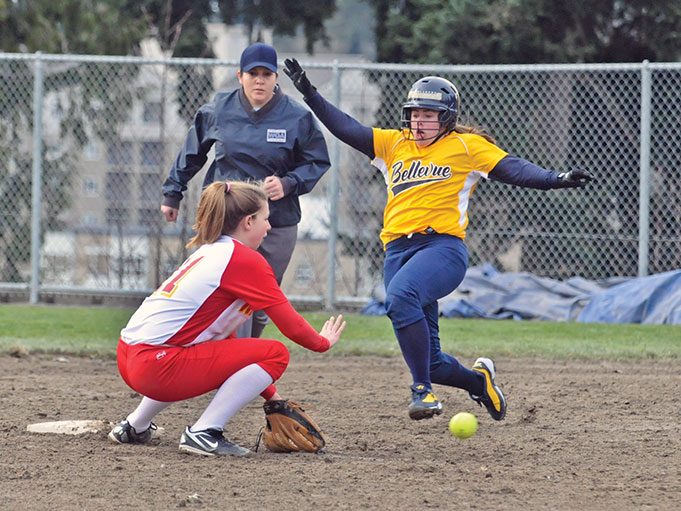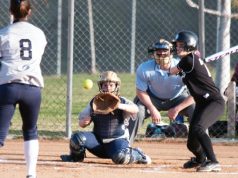Although most umpires would prefer working in crews of three or four, the two-umpire system, if used properly, actually provides for good coverage in most situations. No umpire positioning system can possibly cover every contingency. But the two-umpire system does provide a lot of bang for the buck. In the three- or four-umpire system, angle and distance are rarely sacrificed. By contrast, the two-umpire system imposes compromises. It is when plays break down that its weaknesses are exposed and become more difficult for umpires to handle.
In the two-umpire system, the ability to obtain good angles on plays is paramount. Angle beats distance every time when covering a play. You’ll work to get an angle where all the elements of the play will be in front of you. The elements of plays usually include the ball and the fielder, often the runner and the base, and sometimes the location where all the elements come together.
When covering a play, work toward getting your best possible angle first and then continue hustling to reduce your distance to the play. The old adage, “There is a close correlation between closeness to the play and correctness of the call,” is an effective method of covering a play.
Avoid “straight-line” officiating whenever possible. Unfavorable straight-lining occurs when the ball, the runner, the fielder, the base and the umpire are all in a straight line. The umpire must work an angle to avoid straight-lining.
Officiating manuals indicate where umpires should go in basic situations: runners on base, ground ball vs. fly ball, etc. But because not every play is exactly the same, umpires must often adjust coverages and angles in order to see plays properly.
For example, with R1 on first base and a ball batted in the infield, the plate umpire will usually trail the batter to first. He or she will watch for three-foot-lane interference, a pulled foot and a swipe tag, and will be ready to cover third, if necessary.
However, when the plate umpire reads a possible trouble play on the action at second base (e.g. an illegal slide, a dropped throw on the front end of a potential double play, etc.), he or she might consider moving farther into the infield to an angle that improves the look at second. On such a play at second, the plate umpire will be more valuable to the umpiring team concept by changing the usual angle and positioning slightly and observing the activity around second without seriously compromising responsibilities should a subsequent play need to be covered.
With no runners aboard, a wild throw to first will cause a base umpire to change angle quickly. By doing so, the umpire can get a better look at a potential ball trapped on the ground beneath F3’s glove, a pulled foot or a tag if the fielder must come off the bag to field the throw.
For tag plays at second or third, try to obtain an angle approximately 90 degrees from the runner’s path to the base. It’s acceptable to be as close as six feet from the play in a tagging situation. For a force play, set up about 18 feet from the base with an angle so you can best compare the arrival of the ball and the runner. It cannot be overstated: Angle is more important than distance.
When the base umpire must hustle to the outfield to cover a sinking line drive, angle is crucial. Running directly at the fielder will result in straight-lining. Moving at an angle that provides a look at the ground in front of the glove as well as the glove will help the umpire determine if the ball hit leather or earth first.
On double steal attempts with runners on first and second, the base umpire must anticipate the play and hustle into the best possible calling position for calls at third or second.
When R2 from second breaks for third, the base umpire must move directly toward the left-field foul line since, unlike baseball, few softball catchers will play on the trailing runner. If the throw is to third, the umpire must continue toward the foul line, stop, set and make the call.
In most cases, R1 will have taken off at the same time as R2 and will be standing on second. In the event R1 has missed a sign and stayed put, or it was a delayed double steal all along, the base umpire must now hustle to get into position for the call at second. That would entail obtaining a far different angle again.
On a fly ball down the third-base line, the plate umpire tries to line up the play by straddling the foul line between home plate and third base to see the ball in relation to the foul line. What most often occurs is the third baseman will inevitably move to a position on the foul line to see if the ball is fair or foul, blocking the view. That situation can be compounded when the third-base coach steps to the foul line and leans over to see fair or foul.
To prevent your line of sight from being broken, it is important to move to the infield or move quickly to foul territory to obtain an angle that will ensure line of sight is unobstructed. The same is true for situations with a left-handed batter and the first-base line.
A good angle and a proper distance determine your proper calling position. Yet your work is far from over. Once you have arrived at your calling position be sure to focus on the vital elements of the play before announcing your decision. A good calling position from a stopped set position goes for naught if you are not focused on the proper elements of the play. You must see the essentials.
What's Your Call? Leave a Comment:
Note: This article is archival in nature. Rules, interpretations, mechanics, philosophies and other information may or may not be correct for the current year.
This article is the copyright of ©Referee Enterprises, Inc., and may not be republished in whole or in part online, in print or in any capacity without expressed written permission from Referee. The article is made available for educational use by individuals.


















